I don’t understand these movies that put so much effort into making it look great, and then seem to expend so little effort on plot and characters. “Sherlock Holmes” (2009) is one of those movies — from the opening shot of a horse-and-carriage chase down a dim London street, it looks incredible; it reminds me of that 2001 Jack the Ripper movie, “From Hell.” I was excited to watch a story unfold in these gritty, historic environs.
And then, the story: Something about a secret society that wants to take over the world. Even the James Bond screenwriters are yawning.
As you probably already know, this isn’t your father’s or grandfather’s Sherlock Holmes — but interestingly, it might be your great-grandfather’s (or great-great-grandfather’s) Sherlock Holmes. Although we picture Holmes as some tweedy middle-aged sleuth from the late 19th century who sucks on a pipe and sometimes pulls out a magnifying glass, apparently that iconic but skewed image was slowly formed through the years.
This movie aims to show us the original Holmes as Arthur Conan Doyle intended him to be. And as played by Robert Downey Jr., the detective has a detached “Here we go again” attitude like … well, like any Robert Downey Jr. character. The famous sidekick, Watson, as played by Jude Law, has a similarly cool demeanor. It’s apparent very quickly that this is a Guy Ritchie movie — lots of attitude and style, kind of fun, but hard to care.
Now, if you want to talk about the set-ups and style choices on a purely abstract level, they are certainly impressive. We get into Holmes’ head as he plans out a series of moves to defeat a street-brawl opponent (MMA for the 19th century, I suppose), then we see him execute the moves at regular speed. Holmes and Watson rescue the damsel (Rachel McAdams) from a meat-processing factory assembly line (the villain has suddenly become an 1800s version of Jigsaw, I guess). A building blows up, and we see the shrapnel fly in slow motion. (I should also note that the music — written like a contemporary action score, but seemingly played with instruments that would be available in Holmes’ day — is compelling.)
But why is Holmes brawling? Why is McAdams in the trap? Why does the building blow up? I don’t mean to say that the film doesn’t answer these questions (it does, probably). It’s just that these sequences seemed like they were there for the sake of spectacle more than story. I didn’t feel like I knew Holmes and Watson as anything more than caricatures (even if they are authentically Conan Doyle caricatures).
Maybe my brain is wired wrong, but I’ve never liked “mysteries” where the viewer isn’t allowed to play along, or any story where something happens but we don’t know why it’s happening until later. To me, it’s lazy writing if I don’t feel engaged as I’m watching the story unfold.
“Sherlock Holmes” ends by setting up the franchise — we are clued into a fresh caper featuring Holmes’ biggest nemesis from those old yarns, Professor Moriarty. Die-hard Holmes geeks will love that, I’m sure. But I won’t be the first in line for the sequel.


